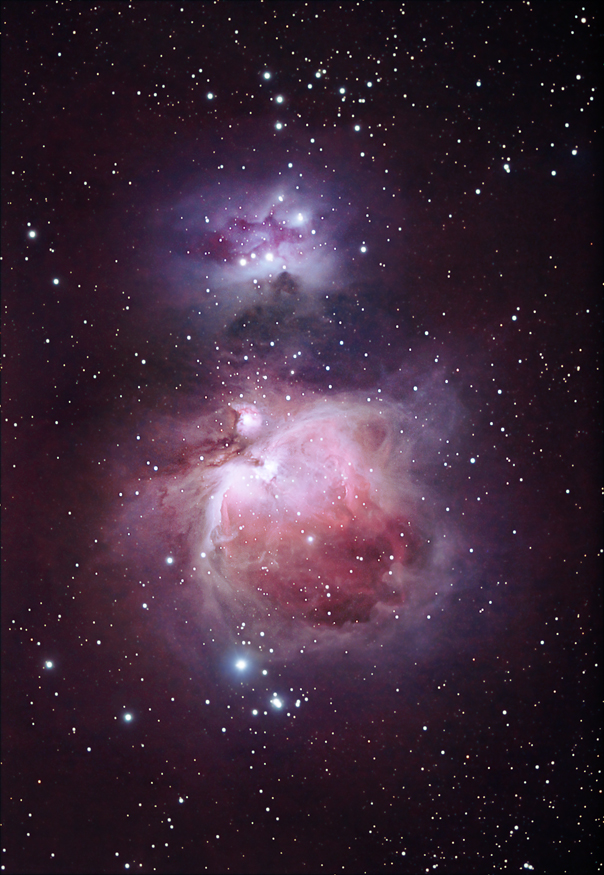The Great Orion Nebula (M42) and NGC 1977 (Running Man
Nebula)
Characteristics:
Magnitude: 5.0
Size: about 1.5 degrees
Distance: 1600 light years
RA: 5h 35m
Dec: minus 5 degrees 35' 54"
Description:
The Great Orion Nebula is the brightest nebula visible to the naked
eye, forming the middle part of the Hunter's sword in the famous
constellation Orion.
It is a breathtaking view in even small telescopes, where
tendrils of gas can be appreciated even without the aid of special
filters. The use of a UHC filter improves contrast significantly
and reveals a
significant amount of faint nebulosity during visual observation.
The typical visual view in a telescope is pale white to faint
green, due to the human eye's poor color response to low light
(especially
in the red, which is emitted by this nebula due to excitation of
hydrogen
gas as a result of radiation from newly formed stars). In this
view,
the Running Man Nebula (NGC 1977) is seen at the top, a beautiful
reflection
nebula that derives its blue color from reflected light of nearby stars.
Photographic Details:
Date: November 23 and October
30, 2003.
Scope: Takahashi Sky 90 at f4.5 with field flattener/focal
reducer, piggybacked on LX90 (which is mounted on a Meade Superwedge).
Autoguider: STV with e-finder.
Camera: Canon 10D.
Filter: IDAS LPS.
Exposures: 12 x 8' (November 23, 2003); 5 x
15"; 5 x 50 " (October 30, 2003), all at ISO 800. Total exposure
time approximately 100 minutes.
Conditions: November 23: Temperature 34 degrees F; average
transparency; average seeing; light winds; October 30: Temperature 38 degrees F; below average
transparency; average seeing; very breezy.
Post-processing: Raw conversion, adaptive
dark frame calibration, alignment, min/max excluded averaging done
in ImagesPlus; Levels, curves,
and
layer mask adjustments in Photoshop; final smoothing done in Pleiades
SGBNR software. The
Trapezium
region consists of 2 different exposures (15" and 50", in order to
capture the dynamic range in this region). 8' exposures were
taken
in order to capture the faint red nebulosity around the outskirts of
the Orion Nebula.
Please
note: Graphics on this website may not be reproduced without
author permission.
Back to Nebulae
Home
